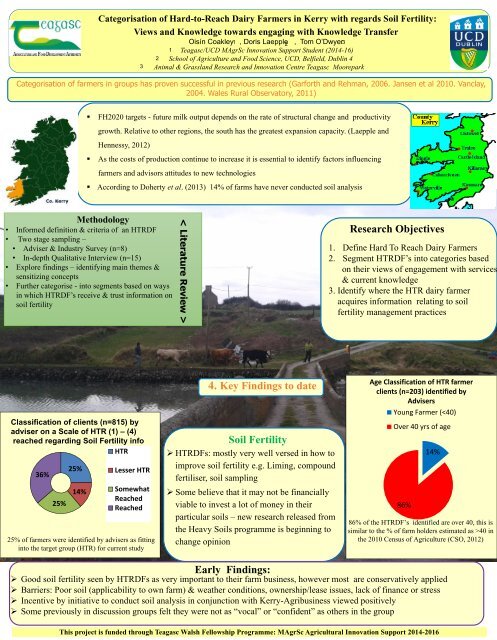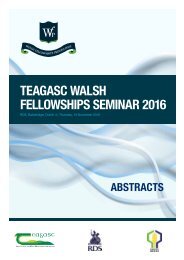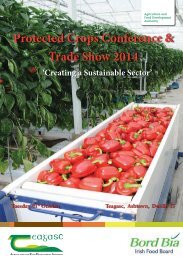Driving Farm Innovation through Knowledge Transfer
1S93ppX
1S93ppX
You also want an ePaper? Increase the reach of your titles
YUMPU automatically turns print PDFs into web optimized ePapers that Google loves.
Categorisation of Hard-to-Reach Dairy <strong>Farm</strong>ers in Kerry with regards Soil Fertility:<br />
Views and <strong>Knowledge</strong> towards engaging with <strong>Knowledge</strong> <strong>Transfer</strong><br />
3<br />
2<br />
1<br />
Oisín Coakley 1 , Doris Laepple , Tom O’Dwyer<br />
Teagasc/UCD MAgrSc <strong>Innovation</strong> Support Student (2014-16)<br />
School of Agriculture and Food Science, UCD, Belfield, Dublin 4<br />
Animal & Grassland Research and <strong>Innovation</strong> Centre Teagasc Moorepark<br />
2<br />
3<br />
Categorisation of farmers in groups has proven successful in previous research (Garforth and Rehman, 2006. Jansen et al 2010. Vanclay,<br />
2004. Wales Rural Observatory, 2011)<br />
• FH2020 targets - future milk output depends on the rate of structural change and productivity<br />
growth. Relative to other regions, the south has the greatest expansion capacity. (Laepple and<br />
Hennessy, 2012)<br />
• As the costs of production continue to increase it is essential to identify factors influencing<br />
farmers and advisors attitudes to new technologies<br />
• According to Doherty et al. (2013) 14% of farms have never conducted soil analysis<br />
Methodology<br />
• Informed definition & criteria of an HTRDF<br />
• Two stage sampling –<br />
• Adviser & Industry Survey (n=8)<br />
• In-depth Qualitative Interview (n=15)<br />
• Explore findings – identifying main themes &<br />
sensitizing concepts<br />
• Further categorise - into segments based on ways<br />
in which HTRDF’s receive & trust information on<br />
soil fertility<br />
< Literature Review ><br />
Research Objectives<br />
1. Define Hard To Reach Dairy <strong>Farm</strong>ers<br />
2. Segment HTRDF’s into categories based<br />
on their views of engagement with services<br />
& current knowledge<br />
3. Identify where the HTR dairy farmer<br />
acquires information relating to soil<br />
fertility management practices<br />
Classification of clients (n=815) by<br />
adviser on a Scale of HTR (1) – (4)<br />
reached regarding Soil Fertility info<br />
HTR<br />
4. Key Findings to date<br />
Soil Fertility<br />
‣ HTRDFs: mostly very well versed in how to<br />
Age Classification of HTR farmer<br />
clients (n=203) identified by<br />
Advisers<br />
Young <strong>Farm</strong>er (40 in<br />
the 2010 Census of Agriculture (CSO, 2012)<br />
Early Findings:<br />
‣ Good soil fertility seen by HTRDFs as very important to their farm business, however most are conservatively applied<br />
‣ Barriers: Poor soil (applicability to own farm) & weather conditions, ownership/lease issues, lack of finance or stress<br />
‣ Incentive by initiative to conduct soil analysis in conjunction with Kerry-Agribusiness viewed positively<br />
‣ Some previously in discussion groups felt they were not as “vocal” or “confident” as others in the group<br />
This project is funded <strong>through</strong> Teagasc Walsh Fellowship Programme: MAgrSc Agricultural <strong>Innovation</strong> Support 2014-2016




